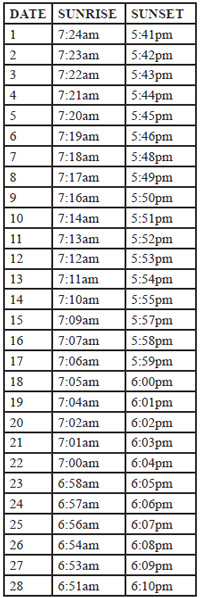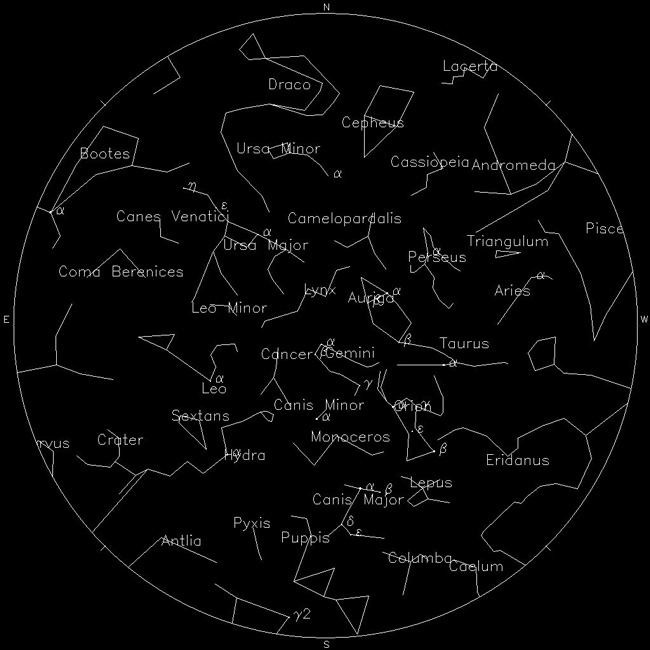Sunrise
and Sunset Times for
February 2008 |
 |
DAYLIGHT
Sunrise and sunset times are calculated for a flat horizon. Actual times may vary depending upon the surrounding landscape. The period of daylight lengthens by one hour and four minutes during February. Twilight extends daylength by several hours. Civil twilight provides adequate light for movement and begins about one-half hour before sunrise. Nautical twilight reveals shapes but not detail and begins approximately one hour before sunrise. Astronomical twilight illuminates the sky with a faint glow. It occurs about one and one-half hours before sunrise. The same progression applies to dusk.
MOON HAPPENINGS
February begins with a first quarter moon high in the western sky at dusk. A nearly full moon rises on the evening of February 8 at 5:03pm. Full moon occurs the following morning, February 9, at 7:49am, shortly after the moon sets. It rises that evening at 6:19pm. On the morning of February 10 the moon rises about one-half hour before Saturn. The bright star near the moon in the early hours of February 14 is Spica (in Virgo). The waning moon reaches its last quarter phase on February 16. On February 17 the bright star near the moon is Antares (in Scorpio). New moon occurs February 24 at 6:35pm. The month ends with a waxing crescent moon paired with Venus in the western sky at dusk. Actual times of moonrise may vary depending upon the surrounding landscape.
METEOR EVENTS
Fireballs are frequently observed along the ecliptic during February. Look for these large meteors, nearly as bright as Venus, high in the sky after 3:00am.
APPARENT DISTANCES IN THE SKY
Apparent distances between celestial objects are measured in degrees. The note in italics below provides a gauge for measuring these distances. You can calibrate the size of your hand with the following test. The stars of the Big Dipper span approximately 20 degrees. Castor and Pollux, the twin stars of Gemini are about 10 degrees apart. The stars in Orion’s belt are separated by about 1.35 degrees. The apparent diameter of both the sun and the moon is 0.5 degrees. The sun and moon often appear larger on the horizon than they do when directly overhead. Using a pencil or your little finger to gauge the diameter at each position will show that this is an illusion. (Try this with a full moon rather than the sun so that you do not damage your eyes.)
Note: Hold your hand at arm’s length to measure apparent distances in the sky. Adjust for the size of your hand. The width of the little finger approximates 1.5 degrees. Middle, ring, and little finger touching represent about 5 degrees. The width of a fist is about 10 degrees. The hand stretched from thumb to little finger equals 20 degrees. The diameter of both the full moon and the sun spans only 0.5 degree.
VISIBLE PLANETS
Jupiter – By midmonth Jupiter is visible in the early dawn sky in Capricornus. It is shining at magnitude -1.9 in the southeastern sky below Mercury and above Mars. It will be difficult to see without a clear view of the eastern horizon.
Mars – The red-orange light of this planet makes it easy to identify. It rises soon after Jupiter in the southeastern sky. Shines at magnitude +1.3, a little dimmer than Mercury which appears above Jupiter. Mars, the lowest of a string of three planets in the morning sky will be the most difficult to see.
Mercury – Find Mercury in the morning sky shortly before sunrise. It’s about 7 degrees above the eastern horizon so will be difficult to see in canyon country. If you can see the crescent moon on the morning of February 22, then look for Mercury directly below it, shining at magnitude +0.6.
Saturn – Look for Saturn as it rises in the eastern sky around 9:00pm at the beginning of the month. It follows Leo across the night sky, with Virgo trailing behind it. By the end of the month it rises at the end of twilight. Shines at magnitude +0.7. Saturn’s rings are now tipped slightly towards us.
Venus – Find the brilliant light of Venus high in the western sky at dusk. Since Venus is an interior planet, it passes through phases just like our moon. It is now in its crescent phase, as it passes between the sun and the earth. Venus increases in brilliance over the next few weeks because of its proximity to Earth. It reaches its brightest magnitude of -4.8 on February 19.
Note: Apparent magnitude values range from -4 to +6 for most planets and visible stars. The lower the value the brighter the object. A decrease of 1.0 magnitude is 2.5 times brighter.
Primary Sources: USGS, U.S. Naval Observatory,
http://www.fourmilab.ch/yoursky/
MAJOR
CONSTELLATIONS this MONTH |
Overhead
Auriga
Canis Minor
Gemini
Orion
Taurus
|
Northward
Cassiopeia
Cepheus
Ursa Major
Ursa Minor
|
Eastward
Cancer
Leo
Bootes
|
Southward
Canis Major
Eridanus
Lepus
|
Westward
Andromeda
Aries
Perseus
Triangulum |
The winter sky features two prominent star clusters. The Hyades are identified as the five stars that form the V of the bull’s head in Taurus. Ten degrees northwest of the Hyades are the six visible stars of the Pleiades. Each cluster represents a cloud of cosmic dust that spawned hundreds of thousands of stars.

Hold the star chart high above
your head and match the compass directions to the direction
you are facing.
Adjust the star chart by orienting Ursa Major (Big Dipper) to match its position
in the sky.
The star chart approximates the
night sky from astronomical twilight to midnight. As the night
and the month progress, the constellations will shift toward
the northwest. |
|